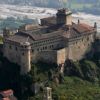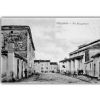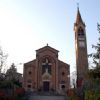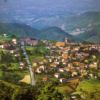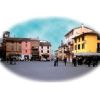
Routes in Chero
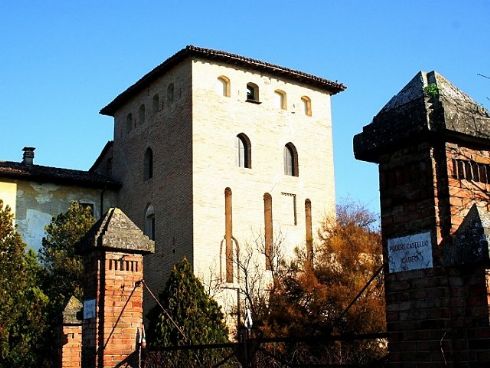
Archaeology, walks through castles and gullies, gastronomy are the three keys to those who decided to visit the Chero. Situated between La val d'Arda and Nure, has among its most important chapters of those related to the activity of oil wells (well three hundred fifty) who had it become, in the first half of the twentieth century, the "small Dallas" Piacenza. From Carpaneto is part sliding along a road that arrives at Monte Santa Franca, meeting gullies,
waterfalls, small towns and centers known as Rustigazzo and Veleja Romana. Around here goes the famous road of wines and flavors.
The discovery of the cuisine of the very valuable touches vineyards Travazzano and Magnano, who provide excellent DOC wines, but also the woods of the valley, rich tasty chestnuts. And just in Carpaneto, natural capital of the valley, is celebrated every year a festival dedicated to the Queen of Piacenza salami, coppa. In this country, since the seventeenth century was an important agricultural center, is worth visiting the ancient castle of the feudal system, the scene of numerous clashes and also, in the sixteenth century, the basis of the raids of Pier Maria Scotti said Buso. The fort, now the town hall, remains part of the building and a fifteenth-century porch with columns of granite and sandstone capitals. The church is dedicated to Saints Fermo and Rustico and has frescoes of the late seventeenth century attributed to the school of Bibbiena and other fifteenth (Virgin and St. Anne) and sixteenth (Madonna and Child, San Rocco and San Sebastian), in addition to a copy of the Madonna's Bowl of Correggio. La Pieve di Carpaneto really has a very ancient origin, around Mille, as evidenced by some scrolls Lombard cathedral of Piacenza and 'existence of a Marian fresco of the fourteenth century.
A few kilometers away from Carpaneto, in val Vezzeno is Gropparello that offers visitors the spectacle of one of the most beautiful castles of Piacentino. The origins of the castle can be traced back to 789, when the fort was given by Charlemagne to the bishop Giuliano di Piacenza. The building, with its irregular plan, built on a rocky hill, is surrounded by walls that slope down to the creek Vezzeno. Excellently preserved and enhanced, in recent years the owners have developed an animation program that has transformed the castle and its "fairytale park" in a great place for family fun. It is a park where children emotionally, with the help of expert guides, are accompanied to the discovery of the medieval world, its secrets and its magic. Of particular interest, within the manor, the armory and some paintings of the modern era (XVII and XVIII), while outside there is, among other things, a manufactured stone that some consider an altar Celtic . A Gropparello you can see, in addition to Gragnana tower built in the mid sixteenth century probably designed by Jacopo Barozzi Vignola said, even the "old church" of the old parish of Cagnano built in locations Gelati, in the X-XI century. This Pieve, that in medieval times extended his power over the valleys of the Chero, Vezzeno and Riglio, was very important, so much so that long was also the residence of the bishop of Piacenza. Along the road that connects to Carpaneto Veleja Romana meet countries that contain surprises: Travazzano, whose castle dating from the eleventh century, received in the Middle Ages many nobles fled the city; but also housed the Emperor Lothair II veteran, in 1136, from the strain of writing the Diet of Roncaglia; Magnano, the homeland of cherries, with a castle
which is one of the most significant examples of fortification: the trapezoidal plan, built in stone, was a lu ngo owned by Scotti; Torre Confalonieri that binds the story of San Corrado. Rezzano, Badagnano, Tabiano and Montezago, with its beautiful church of the early twentieth century, small countries are placed in an area rich in fossil shells and a time marked by the presence of numerous mills. Rustigazzo, a few miles from the park try nciale of Mount Moria, is the most populous borough average val Chero, with many shops and other entertainment initiatives, organized especially in summer.
Particularly interesting is the visit to Veleja Romana, one of the archaeological sites, the most important in northern Italy. Inhabited by Ligurian Veleiates was, from the first to the fifth century AD, an important Roman town and capital of a vast mountain area that stretched from the Parma area until the Trebbia. The Romans conquered it in a totally peaceful and in 42 AD obtained the Roman citizenship. Veleja was an important point of commercial exchange, but also a busy tourist center-spa, able to recall the "celebrities" of imperial Rome. In the period between the late third and early fourth century began the decline of the town. From the middle of the eighteenth century, excavations began at the behest of the Duke of Parma, Philip Bourbon, since in 1747 had been found accidentally Tabula food Trajan, a bronze inscription dating from the first half of the second century AD The first round of excavations, which continued until 1765, brought to light important finds: stones, inscriptions, pottery, the bronze statues of the Winged Victory and dell'Ercole Bibace, the twelve statues of the Julio-Claudian cycle of the basilica and the thermal plant . In later centuries, several times, were made other important investigations were initiated and rehabilitation work, as in the fifties of the twentieth century, the reconstruction of the columns of the hole and the amphitheater that hosts a few years ago, in the summer, theater performances . Antiquarium the visitor can admire, among other things, the kits of the tombs of the Ligurian necropolis that was discovered by Giovanni Mariotti in 1876 not far from the town Roman, a plaster copy of a large fragment of the bronze table with the Lex de Galia Cisalpina, a stone statue
(Jupiter Ligure) by local artists of the first century BC An excursion to Mount Santa Franca can conclude the visit to Val Chero.
waterfalls, small towns and centers known as Rustigazzo and Veleja Romana. Around here goes the famous road of wines and flavors.
The discovery of the cuisine of the very valuable touches vineyards Travazzano and Magnano, who provide excellent DOC wines, but also the woods of the valley, rich tasty chestnuts. And just in Carpaneto, natural capital of the valley, is celebrated every year a festival dedicated to the Queen of Piacenza salami, coppa. In this country, since the seventeenth century was an important agricultural center, is worth visiting the ancient castle of the feudal system, the scene of numerous clashes and also, in the sixteenth century, the basis of the raids of Pier Maria Scotti said Buso. The fort, now the town hall, remains part of the building and a fifteenth-century porch with columns of granite and sandstone capitals. The church is dedicated to Saints Fermo and Rustico and has frescoes of the late seventeenth century attributed to the school of Bibbiena and other fifteenth (Virgin and St. Anne) and sixteenth (Madonna and Child, San Rocco and San Sebastian), in addition to a copy of the Madonna's Bowl of Correggio. La Pieve di Carpaneto really has a very ancient origin, around Mille, as evidenced by some scrolls Lombard cathedral of Piacenza and 'existence of a Marian fresco of the fourteenth century.
A few kilometers away from Carpaneto, in val Vezzeno is Gropparello that offers visitors the spectacle of one of the most beautiful castles of Piacentino. The origins of the castle can be traced back to 789, when the fort was given by Charlemagne to the bishop Giuliano di Piacenza. The building, with its irregular plan, built on a rocky hill, is surrounded by walls that slope down to the creek Vezzeno. Excellently preserved and enhanced, in recent years the owners have developed an animation program that has transformed the castle and its "fairytale park" in a great place for family fun. It is a park where children emotionally, with the help of expert guides, are accompanied to the discovery of the medieval world, its secrets and its magic. Of particular interest, within the manor, the armory and some paintings of the modern era (XVII and XVIII), while outside there is, among other things, a manufactured stone that some consider an altar Celtic . A Gropparello you can see, in addition to Gragnana tower built in the mid sixteenth century probably designed by Jacopo Barozzi Vignola said, even the "old church" of the old parish of Cagnano built in locations Gelati, in the X-XI century. This Pieve, that in medieval times extended his power over the valleys of the Chero, Vezzeno and Riglio, was very important, so much so that long was also the residence of the bishop of Piacenza. Along the road that connects to Carpaneto Veleja Romana meet countries that contain surprises: Travazzano, whose castle dating from the eleventh century, received in the Middle Ages many nobles fled the city; but also housed the Emperor Lothair II veteran, in 1136, from the strain of writing the Diet of Roncaglia; Magnano, the homeland of cherries, with a castle
which is one of the most significant examples of fortification: the trapezoidal plan, built in stone, was a lu ngo owned by Scotti; Torre Confalonieri that binds the story of San Corrado. Rezzano, Badagnano, Tabiano and Montezago, with its beautiful church of the early twentieth century, small countries are placed in an area rich in fossil shells and a time marked by the presence of numerous mills. Rustigazzo, a few miles from the park try nciale of Mount Moria, is the most populous borough average val Chero, with many shops and other entertainment initiatives, organized especially in summer.
Particularly interesting is the visit to Veleja Romana, one of the archaeological sites, the most important in northern Italy. Inhabited by Ligurian Veleiates was, from the first to the fifth century AD, an important Roman town and capital of a vast mountain area that stretched from the Parma area until the Trebbia. The Romans conquered it in a totally peaceful and in 42 AD obtained the Roman citizenship. Veleja was an important point of commercial exchange, but also a busy tourist center-spa, able to recall the "celebrities" of imperial Rome. In the period between the late third and early fourth century began the decline of the town. From the middle of the eighteenth century, excavations began at the behest of the Duke of Parma, Philip Bourbon, since in 1747 had been found accidentally Tabula food Trajan, a bronze inscription dating from the first half of the second century AD The first round of excavations, which continued until 1765, brought to light important finds: stones, inscriptions, pottery, the bronze statues of the Winged Victory and dell'Ercole Bibace, the twelve statues of the Julio-Claudian cycle of the basilica and the thermal plant . In later centuries, several times, were made other important investigations were initiated and rehabilitation work, as in the fifties of the twentieth century, the reconstruction of the columns of the hole and the amphitheater that hosts a few years ago, in the summer, theater performances . Antiquarium the visitor can admire, among other things, the kits of the tombs of the Ligurian necropolis that was discovered by Giovanni Mariotti in 1876 not far from the town Roman, a plaster copy of a large fragment of the bronze table with the Lex de Galia Cisalpina, a stone statue
(Jupiter Ligure) by local artists of the first century BC An excursion to Mount Santa Franca can conclude the visit to Val Chero.
- Visit Val VezzenoHow many beautiful surprises reserve our province! This I say and I repeat every time "Routes piacentini" calls me ...
- visit to GropparelloPopular in summer for its happy hillside location is known for its castles. In fact the history of the country is linked to that of its castle that rises ...
- capital of Chero and capital of the cupThe country has a strong connotation of ancient fortress that gives the village a special charm. Nearby ...
-
Search
-
Categories
- Farmhouses
- Farmhouse in Piacenza and province
- Autumn/Winter Piacentino
- Ferragosto 2105 in Agriturismo
- Restaurants
- Visit Piacentino
- Piacenza Museums
- Castello di Rivalta
- Excursions in the Province of Piacenza
- Recipes Piacentine
- Wines Piacentini
- Typical Products Piacentini
- Events in Piacentino
- Illustrious Piacentini
- Art Piacentina
- library Piacenza
- Photogallery from Piacentino
- Contacts
- Download App
- Mangiare Piacentino
- holiday packages
-
Topics
- Art and Artists Piacentini
- Cooking and traditions
- Illustrious Piacentini
- castle of Rivalta
- Christmas and New Year in Farms
- Valentine in Farms
- Ferragosto in Farms
- Eating in Piacentino
- Farms in Emilia Romagna
- Common Piacentini advocates
- Events in Piacentino
- Emilia Romagna and its Traditions
- Tourism and Piacenza Province
- Routes in Piacenza
- Discipline in Emilia Romagna
- Freetime in Piacentino
- Videos and Movies
- Phoyogallery of Piacentino
- legend Symbols







